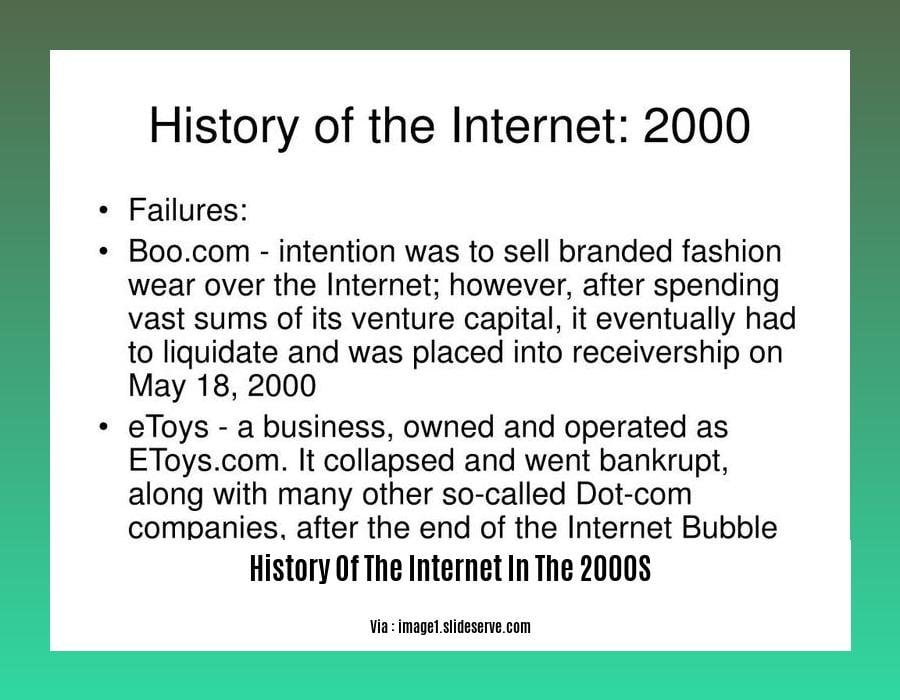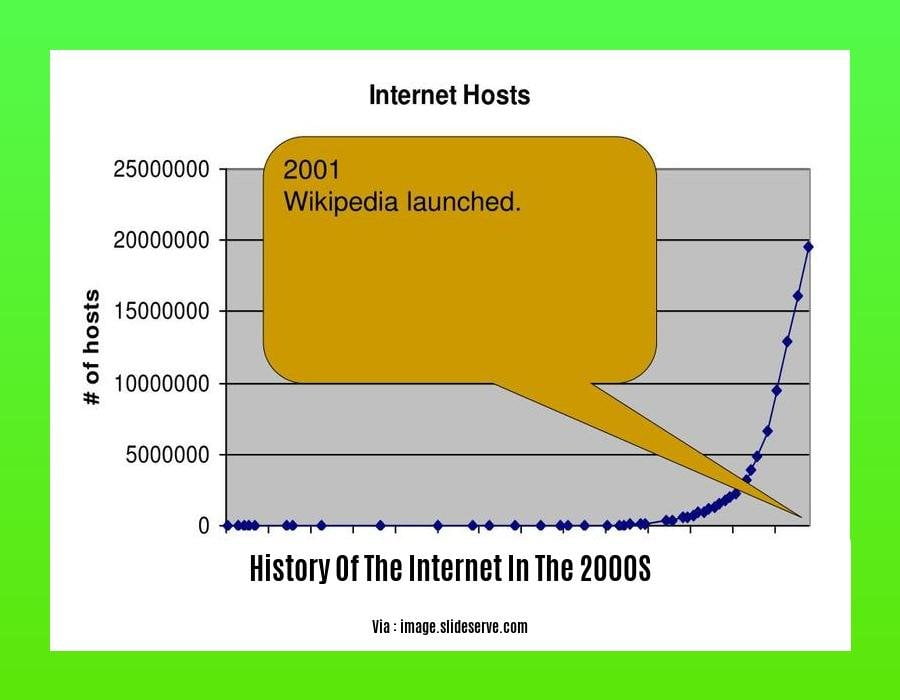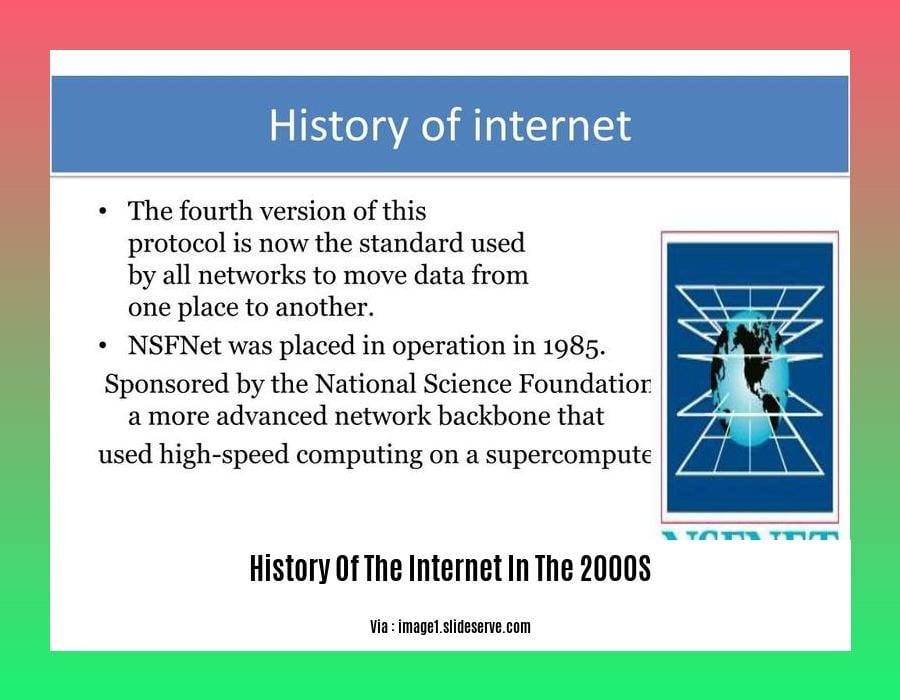Journey with us as we delve into [The Dawn of a New Era: Unraveling the History of the Internet in the 2000s]. In this captivating exploration, we’ll trace the pivotal moments, innovations, and cultural shifts that transformed the internet into the ubiquitous force it is today.
Key Takeaways:
Broadband technology in the early 2000s allowed users to be online and make phone calls at the same time.
In the 1980s, the internet was similar to a modern version but had limited capabilities.
Dial-up internet became popular in the 1990s, and commercial internet service providers offered connections to regular households.
The Covid-19 pandemic accelerated the use of the internet for remote work, online education, and entertainment.
Streaming services made TV and movies more accessible online in the 2010s.
The percentage of American adults using computers rose from 15% in 1984 to 42% in 1990.
The World Wide Web was introduced in 1991, allowing users to access documents, images, and videos across different websites.
History Of The Internet In The 2000s

The 2000s marked a pivotal decade in the evolution of the internet, witnessing a surge of technological advancements and a profound impact on society and culture. Let’s delve into the key milestones and trends that shaped the internet’s landscape during this transformative era:
The Dawn of Broadband Technology:
The introduction of broadband technology in the early 2000s revolutionized internet connectivity. It enabled users to seamlessly navigate the web, make phone calls, and engage in various online activities simultaneously. This breakthrough significantly enhanced internet accessibility and paved the way for bandwidth-intensive applications.
Emergence of Social Networking Platforms:
The early 2000s witnessed the rise of social networking platforms that fundamentally changed the way people communicated and connected. Social media giants like Facebook and Twitter gained immense popularity, enabling users to share updates, photos, and videos, fostering virtual communities, and transforming the dynamics of online communication.
E-commerce Takes Center Stage:
Online shopping gained traction during the 2000s, transforming consumer behavior and reshaping the retail industry. Amazon emerged as a behemoth in the e-commerce sector, and other major players like eBay and Alibaba gained significant market share. The convenience and accessibility of online shopping revolutionized retail experiences.
The Proliferation of Web 2.0:
Web 2.0 technologies and applications emerged, emphasizing user-generated content and interactive experiences. Platforms like YouTube, Wikipedia, and Blogs allowed users to actively participate in creating and sharing information, redefining the traditional roles of consumers as passive recipients of content.
The Mobile Internet Revolution:
The early 2000s witnessed the dawn of the mobile internet, with the introduction of smartphones and 3G networks. The symbiosis of mobile devices and internet connectivity enabled anytime, anywhere access to information and services, radically altering the way people communicated, consumed media, and conducted business.
The Rise of Cloud Computing:
The concept of cloud computing gained momentum in the 2000s, offering businesses and individuals the ability to store and access data and applications over the internet rather than on local devices. Cloud-based services like Google Cloud and Amazon Web Services transformed the way organizations managed their IT infrastructure.
The impact of the internet in the 2000s was multi-faceted, profoundly affecting communication, commerce, entertainment, and information access. It transformed the way people connected, facilitated global collaboration, empowered individuals with vast knowledge, and reshaped entire industries. As we delve into the history of the internet in the 2000s, we gain invaluable insights into the origins of today’s digital landscape.
Intrigued by the evolution of the internet and wifi? Dive into our in-depth exploration of its journey, from humble beginnings to its current global reach.
Delve into the history of the internet and social media, uncovering how these platforms transformed human interaction and reshaped the digital landscape.
Embark on a journey through the history of internet access, tracing its humble origins to the explosive growth that brought connectivity to the masses.
Discover the pivotal moments and key figures that shaped the history of the internet Wikipedia, the free encyclopedia that democratized access to information.
In a nutshell, the history of the internet is a captivating tale of innovation, collaboration, and the relentless pursuit of connecting the world.
Impact of E-commerce: The rise of online shopping and e-commerce giants like Amazon and eBay changed consumer behavior and created new opportunities for businesses.

Imagine a world where shopping meant long lines, crowded malls, and limited choices. Enter the early 2000s, when the internet transformed the way we buy and sell, ushering in the era of e-commerce.
Key Takeaways:
Online retail disrupted traditional brick-and-mortar stores, offering convenience, accessibility, and a wider selection of products.
E-commerce giants like Amazon revolutionized online shopping with customer-centric policies, efficient logistics, and personalized recommendations.
Increased consumer trust in online transactions boosted the growth of e-commerce, leading to a shift in consumer behavior and spending habits.
The ease and affordability of online shopping encouraged entrepreneurship and the rise of small businesses, creating new opportunities and fostering economic growth.
Mobile technology and smartphones further accelerated the adoption of e-commerce, enabling seamless shopping experiences anywhere, anytime.
E-commerce: A Paradigm Shift in Consumer Behavior
The advent of e-commerce brought a paradigm shift in consumer behavior. The convenience of shopping from home, 24/7 availability, and easy access to product information and reviews reshaped the retail landscape. Consumers embraced the ease of comparing prices and products from multiple retailers, leading to increased competition and lower prices.
E-commerce Giants: The New Titans of Retail
In this transformative era, e-commerce giants emerged as the new titans of retail. Amazon, with its customer-centric policies, efficient logistics, and personalized recommendations, became the epitome of online shopping. Its vast selection of products, competitive pricing, and fast delivery redefined consumer expectations. eBay, on the other hand, revolutionized online auctions, creating a platform for individuals and small businesses to connect with a global audience.
Banking on Trust: The Cornerstone of E-commerce Growth
As online shopping gained traction, building trust became paramount. Secure payment gateways, customer reviews, and robust privacy policies instilled confidence in consumers, encouraging them to embrace digital transactions. This trust played a crucial role in the growth of e-commerce, paving the way for a seamless and secure online shopping experience.
Entrepreneurship and Economic Opportunities
E-commerce not only disrupted traditional retail but also opened up new avenues for entrepreneurship. The low barriers to entry and the ability to reach a global audience empowered individuals and small businesses to launch their online ventures. This surge in e-commerce entrepreneurship contributed to economic growth and job creation, fostering a vibrant and diverse digital economy.
Mobile Shopping: The Ultimate Convenience
The rise of mobile technology and smartphones took e-commerce to new heights. The convenience of shopping on the go, anytime, anywhere, further accelerated the adoption of e-commerce. Mobile-friendly websites and dedicated shopping apps enhanced the user experience, making online shopping even more accessible and convenient.
Sources:
The Rise of Ecommerce in the 2000s
The Impact of E-commerce on Consumer Behavior
Emergence of Web 2.0: The introduction of Web 2.0 technologies, characterized by user-generated content, social sharing, and dynamic web applications, transformed the internet into a more interactive and collaborative space.
Key Takeaways:
- Web 2.0 technologies revolutionized the internet, fostering user-generated content, social interaction, and dynamic web applications.
- Web 2.0 empowered individuals and communities to become active participants in shaping the internet’s content and structure.
- Examples of Web 2.0 technologies include Wikipedia, blogs, social media platforms, and video-sharing platforms.
- Web 2.0 transformed online communication, entertainment, and information access, fostering new forms of digital collaboration and interaction.
In the early 2000s, the internet underwent a seismic shift with the emergence of Web 2.0 technologies. This transformative era witnessed the rise of user-generated content, social sharing, and dynamic web applications, propelling the internet into a more interactive and collaborative space.
Unlike its predecessor, Web 1.0, which primarily consisted of static websites and one-way communication, Web 2.0 technologies empowered individuals and communities to become active participants in shaping the internet’s content and structure. This paradigm shift opened up unprecedented opportunities for online engagement, creativity, and information sharing.
Examples of Web 2.0 technologies that epitomize this shift include Wikipedia, the free online encyclopedia built and maintained by volunteer contributors; blogs, personal websites where individuals share their thoughts and experiences; social media platforms like Facebook and Twitter, which connect people across the globe; and video-sharing platforms like YouTube, where users can upload and share videos.
The impact of Web 2.0 technologies was profound and far-reaching. It transformed online communication, entertainment, and information access. Social media platforms enabled people to connect with friends, family, and like-minded individuals, fostering new forms of digital communities and interactions. Online entertainment options proliferated, with video-sharing platforms becoming popular destinations for content creators and consumers alike. Access to information became more democratized, as individuals could now contribute to and curate online content, challenging traditional gatekeepers of information.
Web 2.0 technologies also spurred the rise of collaborative projects and initiatives. Wikipedia epitomizes this collaborative spirit, with millions of volunteer contributors working together to create a vast repository of knowledge. Open-source software projects, where developers collaborate to create and improve software, also gained traction during this era.
The emergence of Web 2.0 technologies fundamentally changed the way people interacted with the internet, transforming it from a passive medium of information consumption to an active platform for engagement, collaboration, and creativity. Its legacy continues to shape the internet landscape today, laying the foundation for the social, interactive, and user-centric web we experience today.
Citation:
**Global Connectivity: The expansion of internet infrastructure and the increasing affordability of internet access led to a significant growth in global internet penetration, connecting more people and facilitating cross-border communication and collaboration.**
Key Takeaways:
- Milestone Era: The 2000s marked a significant era in internet history, characterized by the expansion of internet infrastructure and the increasing affordability of internet access.
- Bridging Borders: The internet facilitated seamless cross-border communication and collaboration, fostering global connections and blurring geographic boundaries.
- Global Connectivity: The rise of internet usage in the 2000s led to a dramatic increase in global internet penetration, connecting billions of people worldwide.
In the 2000s, the internet underwent a transformation that would reshape the world as we know it. The decade witnessed an unprecedented expansion of internet infrastructure, making the internet more accessible and affordable than ever before. Consequently, global internet penetration skyrocketed, connecting billions of people across the globe.
This remarkable surge in connectivity had a profound impact on communication, collaboration, and commerce. For the first time, people from different countries could seamlessly interact in real-time, fostering cross-border friendships, business partnerships, and cultural exchange. The internet’s global reach enabled individuals to share ideas, experiences, and perspectives like never before.
The increasing affordability of internet access also played a pivotal role in driving global connectivity. As the cost of internet services decreased, more and more people, especially in developing countries, gained access to the digital realm. This democratization of the internet empowered individuals with information, knowledge, and opportunities that were previously out of reach.
The internet’s transformative power extended beyond individuals to businesses and organizations. The global reach of the internet enabled companies to expand their markets, collaborate with international partners, and reach a wider customer base. E-commerce flourished, allowing businesses to sell their products and services to a global audience. Additionally, the internet facilitated remote work and flexible work arrangements, breaking down geographical barriers and expanding employment opportunities.
The expansion of global internet connectivity in the 2000s had a profound impact on societies, economies, and cultures worldwide. It fostered a sense of global community, stimulated economic growth, and accelerated the exchange of ideas and information. The internet became an indispensable tool for education, healthcare, and civic engagement, empowering individuals and transforming the way we live, work, and connect with the world.
Sources:
ITU: Facts and Figures 2022: Latest on global connectivity amid headwinds
Alliance for Affordable Internet: 2021 Affordability Report
FAQ
Q1: How did the internet evolve in the 2000s?
A1: The 2000s witnessed significant advancements in internet technology, including the rise of broadband, the introduction of the World Wide Web, and the emergence of social media platforms. These developments transformed the way people communicated, accessed information, and conducted business.
Q2: What impact did broadband technology have on internet usage in the 2000s?
A2: Broadband technology revolutionized internet usage in the 2000s by enabling faster and more reliable connections. This led to a surge in online activities, such as streaming media, online gaming, and video conferencing, which were previously impractical with dial-up connections.
Q3: How did the internet transform communication in the 2000s?
A3: The 2000s saw the rise of social media platforms, instant messaging services, and video conferencing tools, which fundamentally changed the way people communicated. These technologies facilitated real-time interactions, enabling individuals to connect with friends, family, and colleagues from anywhere in the world.
Q4: What were some of the key technological advancements that shaped the internet in the 2000s?
A4: The 2000s witnessed several technological advancements that reshaped the internet landscape. These included the development of wireless internet technologies like Wi-Fi, the introduction of smartphones and tablets, and the emergence of cloud computing services, which provided on-demand access to computing resources and storage.
Q5: How did the internet impact business and e-commerce in the 2000s?
A5: The internet’s growth in the 2000s had a profound impact on businesses and e-commerce. Online shopping gained popularity as consumers embraced the convenience and selection offered by e-commerce platforms. Additionally, businesses increasingly utilized the internet for marketing, customer service, and supply chain management.










